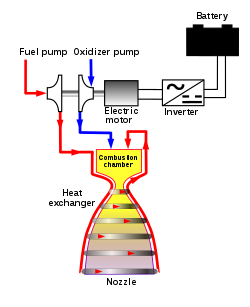Rocket engine operation method

The electric-pump-fed engine is a bipropellant rocket engine in which the fuel pumps are electrically powered, and so all of the input propellant is directly burned in the main combustion chamber, and none is diverted to drive the pumps. This differs from traditional rocket engine designs, in which the pumps are driven by a portion of the input propellants.
An electric cycle engine uses electric pumps to pressurize the propellants from a low-pressure fuel tank to high-pressure combustion chamber levels, generally from 0.2 to 0.3 MPa (29 to 44 psi) to 10 to 20 MPa (1,500 to 2,900 psi). The pumps are powered by an electric motor, with electricity from a battery bank.
Electrical pumps had been used in the secondary propulsion system of the Agena upper stage vehicle.
As of December 2020, the only rocket engines to use electric propellant pump systems are the Rutherford engine, ten of which power the Electron rocket, and the Delphin engine, five of which power the first stage of Astra Space's Rocket 3. On 21 January 2018, Electron was the first electric pump-fed rocket to reach orbit.
In comparison to turbo-pumped rocket cycles such as staged combustion and gas generator, an electric cycle engine has potentially worse performance due to the added mass of batteries, but may have lower development and manufacturing costs due its mechanical simplicity, its lack of high temperature turbomachinery, and its easier controllability.
See also
- Combustion tap-off cycle
- Expander cycle
- Gas-generator cycle
- Pressure-fed engine
- Rocket engine
- Solid-propellant rocket
- Staged combustion cycle
References
- George Paul Sutton (2006). History of Liquid Propellant Rocket Engines. AIAA. p. 126. ISBN 9781563476495.
- ^ "Propulsion". Rocket Lab. Archived from the original on 19 September 2016. Retrieved 19 September 2016.
- "Astra scrubs DARPA launch challenge attempt". 2 March 2020. Retrieved 17 December 2020.
- Ryan, Holly (21 January 2018). "Blast off! Rocket Lab successfully reaches orbit". The New Zealand Herald. Retrieved 21 January 2018.
- Rachov, Pablo (2010). "Electric feed systems for liquid propellant rocket engines" (PDF). Archived from the original (PDF) on 21 January 2018. Retrieved 3 February 2018.
| Spacecraft propulsion | |||||||||
|---|---|---|---|---|---|---|---|---|---|
| Concepts | |||||||||
| Physical propulsion | |||||||||
| Chemical propulsion |
| ||||||||
| Electrical propulsion |
| ||||||||
| Nuclear propulsion |
| ||||||||
| External power | |||||||||
| Related concepts | |||||||||